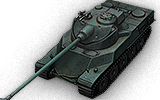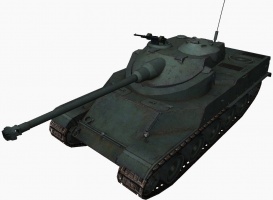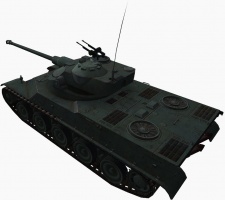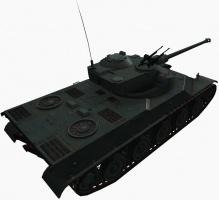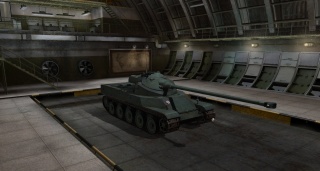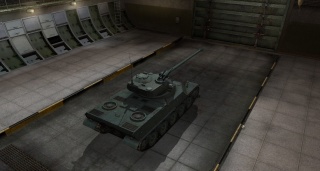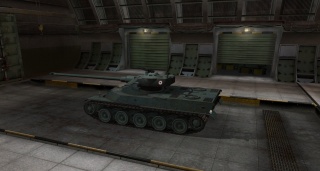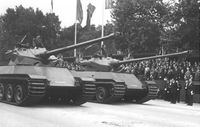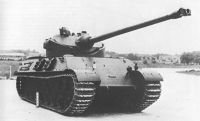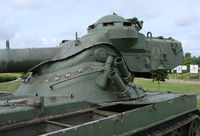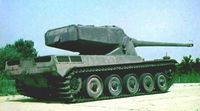Что ставить на амх 50 100
Тяжелый танк AMX 50 100
Здравствуйте танкисты! Сегодня я начинаю рассматривать ветку французских ТТ. Но начну я рассматривать не с низких уровней, а сразу с высоких. Начну именно с них, потому что именно 3 последние машины являются наиболее интересными, необычными, требуют особого подхода.
Они имеют барабан заряжания. Конечно сейчас многие из вас скажут, что ничего в этом особенного нет, но это абсолютно не так. Давайте не будем сильно углубляться раньше времени, а перейдем непосредственно к самой машине. Там мы все рассмотрим более подробно. Итак, перед вами первый тяжелый танк Франции с барабаном заряжания. Танк, который обладает просто огромным уроном за короткий промежуток времени. Танк, который больше напоминает СТ, чем ТТ. Танк, бронирование которого, спасет только от дождя. И тем не менее встреча с которым очень опасна. Встречайте AMX 50 100:
Итак, машина 8 уровня. Это первый тяжелый танк Франции оснащенный барабаном заряжания. Цена данного чуда составляет 2 552 500 кредитов. Сумма достаточно большая, а учитывая установку дополнительного оборудования, переобучение экипажа и прочие мелочи выходит достаточно круглая сумма. Но не стоит на этом сильно зацикливаться. Впереди только приятные эмоции.
Я всегда говорил, что хороший экипаж на машина 5+ уровня достаточно важен. Поскольку это машина 8 уровня я советую вам обучить его сразу до 100%, благо экипаж с предыдущего танка подойдет (хоть на AMX 50 100 членов экипажа и меньше, но специальности сохранились). Вот список этих специальностей:
Обучить экипаж до 100% можно 2 способами:
Тут нас ждет достаточно приятный сюрприз. Топовый двигатель, радиостанция и предтоповое орудие уже должно быть открыто на предыдущем танке. Для возведения машины в топовое состояние нужно относительно немного, всего 50 000 ед. опыта =)
Как ни крути, а ее необходимо установить в 1-ю очередь. Благо стоит она всего 16 000 ед. опыта, можно открыть и за свободный впринципе.
Предтоповое и топовое орудия обладают достаточно хорошими показателями бронепробития и урона, точность тоже на высоте. Перезарядка 40 секунд конечно достаточно большая, но другого выбора у нас просто нет.
Вот еще сравнение в скриншотах:
Топ. двигатель у нас уже должен быть открыт, просто устанавливаем. Динамики он добавит очень много, а для нас это достаточно важно.
Я уже писал, что хорошая радиостанция крайне важна для комфортной и успешной игры. Повторю еще раз:
Для эффективной игры вам необходимо знать, что творится в другой части карты. Если вы не знаете, что происходит например на другом фланге вы не можете принять правильного решения и задаете себе вопросы:
Поэтому ставим хорошую радиостанцию в обязательном порядке.
В целом выделю такие плюсы и минусы танка:
Оптимальный вариант прокачки:
Тактика
Балансный вес:
Как видно из таблицы мы попадаем в бои 8, 9 и 10 уровня. Как правило мы будем воевать с 8 и 9 уровнями. Тут нам играть достаточно комфортно, с 10 конечно будет не так комфортно, но если думать что делаешь все относительно неплохо.
Дополнительное оборудование:
Впринципе вместо последнего можно поставить ящик для ускорения ремонта (500 000 кредитов) или просветленную оптику для увеличения обзора (500 000 кредитов).
Снаряжение:
Тут все впринципе стандартно как и везде)))
Перки для экипажа:
АМХ 50 100 — тяжелый французский танк 8 уровня WOT

ТТХ АМХ 50 100
Начнем наш обзор с возможности машины к обзору. Здесь он равен 380 метрам. Это хороший обзор для тяжа восьмого уровня, однако при желании значения всегда можно скорректировать.
Подвижность у машины просто отличная. Учитывая, что весит танк до 50 тонн, он обладает мощностью двигателя в 575 л.с. Эти показатели составляют удельную мощность танка – 11,71 л.с./т.
Максимальная скорость тяжа – 51 км/ч, скорость поворота – 30 град/с, поворота башни – 32 град/с. Это отличный результат для тяжелого танка, у него большое преимущество не только в скорости, но и в маневренности перед одноклассниками.
Бронирование АМХ 50 100
Машина очень плохо бронирована. Это типично для французской техники, однако это осознание не защитит наш танк в бою.
Запас прочности здесь определяется значением в 1 400 единиц. Бронирование корпуса – 90/35/30 мм, башни – 90/30/30 мм. Таким образом, простреливать эту технику будут абсолютно все. Чтобы играть эффективно, придется проявлять творческий подход в управлении ТТ-8.
Орудие
Пушка у француза спорная. С одной стороны мы видим отличные параметры бронепробития, а с другой – хромающую точность.
Точность этой пушки – слабая сторона вооружения АМХ 50 100. Разброс здесь большой – 0,38 на 100 метров, а время сведения – 3 секунды. Стабилизация откровенно плохая, так что эффективность барабана будет зависеть только от умений танкиста. Перезаряжается барабан полностью за 50 секунд.
Углы вертикальной наводки не очень комфортные. Пушка вниз гнется всего на 6 градусов и поднимается на 13.
Преимущества и недостатки
Для того, чтобы упорядочить в голове характеристики АМХ 50 100 и в дальнейшем верно определиться с модулями и перками, представим все сильные и слабые стороны машины в виде пунктов.
Оборудование для АМХ 50 100
Целью установки модулей является обеспечение более комфортной игры. «Досылатель» сюда установить не получится, хотя мы рекомендуем его очень часто. Мы предлагаем вот такое оборудование:
Для тех, чей стиль игры предполагает быстрое сведение, последний пункт можно заменить на « усиленные приводы наводки ». В остальных случаях ранее предложенный вариант будет работать отлично.
Обучение экипажа
Перки – важная часть прокачки любого танка. Наша задача – сделать машину как можно комфортнее и эффективнее.
Мы предлагаем обучить экипаж в таком порядке:
Снаряжение для АМХ 50 100
Снаряжение выбрать проще. Если вы чувствуете недостаток в серебре, берите стандартный комплект в виде:
При возможности взять премиумный набор, берем именно его:
Тактика игры на АМХ 50 100
Данный танк предполагает постоянный расчет, обдумывание каждого действия и мониторинг ситуации в бою.
Этот француз силен, однако играть нужно на нем с максимальной аккуратностью. Никогда не нужно выезжать на превосходящее количество врага, а также нужно постоянно помнить про свой запас прочности. В том случае, если противник застанет вас за перезарядкой или вы не рассчитаете количество снарядов в барабане, не отправив противника в ангар сразу, в этом ангаре точно окажетесь вы.
В бою нужно очень хорошо рассчитывать оставшиеся снаряды в барабане. Перезаряжается он долго. Эти 50 секунд нужно находится вне видимости врага. Средние и ближние дистанции – лучшее местонахождение данного танка.
Кстати, всегда старайтесь находится близко к союзникам, так будет исключено ваше попадание в ангар, если вы плохо рассчитаете время.
АМХ 50 100 – очень интересный танк, который предлагает разные стили ведения боя, а также барабанную систему заряжания, которая точно не оставит равнодушными большинство танкистов.
Видео обзоры танка АМХ 50 100
Блокировка интернет-ресурсов на территории Украины
Стала доступна предзагрузка обновления 1.10.1.1 WOT
Инвайт-код для WOT на сентябрь 2018 [7 дней према, 500 голды и премиум танк Т-127]
AMX 50 100
AMX 50 100
2,552,500  Cost Cost |
| 1400 280 HP Hit Points |
| 49.1/50 27.93/57 t Weight Limit |
| 575 850 hp Engine Power |
| 51/20 km/h Speed Limit |
| 30 32 deg/s Traverse |
| 11.71 30.43 hp/t Power/Wt Ratio |
| No No Pivot |
Shell Cost
Burst Length: 1 rounds
Magazine Size: 6 rounds
Cycle Time: 2.73 s
Magazine Reload Times
Nominal: 35 s
50% Crew: 44.55 s
75% Crew: 39.2 s
100% Crew: 35 s
With Vents: 34.2 s
With Vents and BiA: 33.56 s
Click here for more information.
Burst Length: 1 rounds
Magazine Size: 6 rounds
Cycle Time: 2.73 s
Magazine Reload Times
Nominal: 50 s
50% Crew: 63.64 s
75% Crew: 56 s
100% Crew: 50 s
With Vents: 48.86 s
With Vents and BiA: 47.94 s
Click here for more information.
Using Shell Type 1 (240 Damage):
Theoretical Damage Per Minute
Nominal: 1802.4
50% Crew: 1728
75% Crew: 1768.8
100% Crew: 1802.4
With Vents: 1807.2
With Vents and BiA: 1814.4
Advantageous Damage Per Minute
Loaded-mag DPM: 2023.2
50% Crew: 2001.6
75% Crew: 2013.6
100% Crew: 2023.2
With Vents: 2025.6
With Vents and BiA: 2028
Click here for more information.
Using Shell Type 2 (240 Damage):
Theoretical Damage Per Minute
Nominal: 1802.4
50% Crew: 1728
75% Crew: 1768.8
100% Crew: 1802.4
With Vents: 1807.2
With Vents and BiA: 1814.4
Advantageous Damage Per Minute
Loaded-mag DPM: 2023.2
50% Crew: 2001.6
75% Crew: 2013.6
100% Crew: 2023.2
With Vents: 2025.6
With Vents and BiA: 2028
Click here for more information.
Using Shell Type 3 (320 Damage):
With wholly penetrating hits
Theoretical Damage Per Minute
Nominal: 2403.2
50% Crew: 2304
75% Crew: 2358.4
100% Crew: 2403.2
With Vents: 2409.6
With Vents and BiA: 2419.2
Advantageous Damage Per Minute
Loaded-mag DPM: 2697.6
50% Crew: 2668.8
75% Crew: 2684.8
100% Crew: 2697.6
With Vents: 2700.8
With Vents and BiA: 2704
Click here for more information.
Using Shell Type 1 (300 Damage):
Theoretical Damage Per Minute
Nominal: 1839
50% Crew: 1794
75% Crew: 1818
100% Crew: 1839
With Vents: 1845
With Vents and BiA: 1848
Advantageous Damage Per Minute
Loaded-mag DPM: 2013
50% Crew: 2007
75% Crew: 2010
100% Crew: 2013
With Vents: 2013
With Vents and BiA: 2013
Click here for more information.
Using Shell Type 2 (300 Damage):
Theoretical Damage Per Minute
Nominal: 1839
50% Crew: 1794
75% Crew: 1818
100% Crew: 1839
With Vents: 1845
With Vents and BiA: 1848
Advantageous Damage Per Minute
Loaded-mag DPM: 2013
50% Crew: 2007
75% Crew: 2010
100% Crew: 2013
With Vents: 2013
With Vents and BiA: 2013
Click here for more information.
Using Shell Type 3 (400 Damage):
With wholly penetrating hits
Theoretical Damage Per Minute
Nominal: 2452
50% Crew: 2392
75% Crew: 2424
100% Crew: 2452
With Vents: 2460
With Vents and BiA: 2464
Advantageous Damage Per Minute
Loaded-mag DPM: 2684
50% Crew: 2676
75% Crew: 2680
100% Crew: 2684
With Vents: 2684
With Vents and BiA: 2684
Click here for more information.
With 50% Crew: 0.471 m
With 75% Crew: 0.411 m
With 100% Crew: 0.364 m
With BiA: 0.356 m
With BiA and Vents: 0.349 m
Maximum possible: 0.334 m
For more details, see Crew
With 50% Crew: 0.446 m
With 75% Crew: 0.389 m
With 100% Crew: 0.345 m
With BiA: 0.338 m
With BiA and Vents: 0.33 m
Maximum possible: 0.317 m
For more details, see Crew
With 50% Crew: 3.716 s
With 75% Crew: 3.245 s
With 100% Crew: 2.877 s
With GLD: 2.615 s
With BiA: 2.813 s
With BiA and Vents: 2.752 s
With both and GLD: 2.502 s
Maximum possible: 2.398 s
For more details, see Crew or Equipment
With 50% Crew: 3.716 s
With 75% Crew: 3.245 s
With 100% Crew: 2.877 s
With GLD: 2.615 s
With BiA: 2.813 s
With BiA and Vents: 2.752 s
With both and GLD: 2.502 s
Maximum possible: 2.398 s
For more details, see Crew or Equipment
With 50% Crew: 298.6 m
With 75% Crew: 339.3 m
With 100% Crew: 380 m
With Recon and Situational Awareness: 399.2 m
With Coated Optics: 418 m
With Binocular Telescope: 475 m
Maximum possible: 544 m
For more details, see Skills or Equipment
With 50% Crew: 298.6 m
With 75% Crew: 339.3 m
With 100% Crew: 380 m
With Recon and Situational Awareness: 399.2 m
With Coated Optics: 418 m
With Binocular Telescope: 475 m
Maximum possible: 544 m
For more details, see Skills or Equipment
With 50% Crew: 322.9 m
With 75% Crew: 369.8 m
With 100% Crew: 417.2 m
With 100% Signal Boost: 480 m
When affected by 100% Relaying: 440 m
Maximum possible: 600.5 m
For more details, see Skills or Equipment
With 50% Crew: 605.4 m
With 75% Crew: 693.4 m
With 100% Crew: 782.2 m
With 100% Signal Boost: 900 m
When affected by 100% Relaying: 825 m
Maximum possible: 1125.9 m
For more details, see Skills or Equipment
Additional Statistics
(Top Configuration)
Camouflage
Terrain Resistance
Dispersion Change Values
The AMX 50 100 is a French tier 8 heavy tank.
The AMX 50 100 heavy tank was a further development of the M4 project. The first prototype was built in 1949. The 55-ton vehicle featured a 100-mm gun in the oscillating turret. The prototype was tested with gasoline and diesel engines from 1950 through 1952. The vehicle never entered mass production nor saw service.
The AMX 50 100 is the first French heavy tank to receive an autoloader, which features a 6 round magazine and an impressive potential damage per clip. The AMX 50 100 is very flexible can be used in a great variety of ways. It’s very fast and mobile and its 100mm SA 47 gun boasts good accuracy, penetration, and damage which allows it be effective in sniping, supporting advancing teammates, and as heavy firepower for medium wolf packs. Similarly to its predecessor, the armor of the AMX 50 100 is very weak and receives full damage from arty and HE shells if hit on the sides and rear. The magazine reload takes 50 seconds which makes a cornered AMX 50 100 very vulnerable. Thus, a good 50 100 always leaves itself an escape route and stays safe until it’s time to unload its powerful cannon.
The AMX 50 100 leads to the AMX 50 120.
Modules / Available Equipment and Consumables
Modules
| Tier | Gun | Penetration (mm) | Damage (HP) | Rate of fire (rounds/minute) | Dispersion (m/100m) | Aiming time (s) | Weight (kg) | Price ( ) |
|---|
Engines
| Tier | Engine | Engine Power (hp) | Chance of Fire on Impact (%) | Weight (kg) | Price ( ) |
|---|
Suspensions
| Tier | Suspension | Load Limit (т) | Traverse Speed (gr/sec) | R min | Weight (kg) | Price ( ) |
|---|
Radios
Compatible Equipment


















Compatible Consumables
Player Opinion
Pros and Cons
Performance
The AMX 50 100 is a glass cannon. Although, the 6-round drum has a tremendous average damage of 1800, extreme care must be taken when driving an AMX 50 100. Its negligible armor attracts enemy fire and often causes a swift trip back to the garage. The perk Sixth Sense is highly recommended as arty are well aware they can hit 50 100’s for full damage. By staying alive you’ll naturally find yourself dealing more and more damage as you reload your drum again and again. In order to maximize survivability and damage potential, a 50 100 must wait for the right opportunity to make use of its strengths. Whether it’s unloading on an enemy caught out in the open, making a dash for arty, supporting your teammates through flanking, or chasing down speedy enemies, the choice of action a 50 100 makes can have a huge effect on the outcome of the battle. Always try to go for the kill, finish off targets you started unloading on, and above all, know when to pull back. Sometimes you won’t be able to unload your entire clip without taking an extra shot from the enemy. Some people might prefer the 90 mm DCA 45 featured first on the ARL 44 over the 100 mm SA47 as the reload of the clip is much shorter (though the reload between shells is the same), and the damage per minute is higher. Also, the shells are much cheaper (255 credits for the 90 mm shells vs 1030 for the 100 mm shells).
The AMX 50 100 is more of a tank destroyer than true heavy in comparison to its fellow Tier 8s; avoid taking the front lines, and never advance alone if possible. Stay observant of both teams and take advantage of opportunities as they come up. Understand that an AMX 50 100 cannot limit itself to a single role constantly. Everything about the 50 100, except armor and horribly long reload, is excellent for its tier. The 50 100 is overall a fun tank to learn and play and is a popular keeper among many Tier 8 aficionados, but only really shines in platoons. Even then, city maps are usually a unpleasant experience for this tank.
The AMX 50 100, due to its characteristics, is commonly used in Team battles and tournaments.
Early Research
Suggested Equipment


External Reviews and Opinions
Gallery
AMX 50 100 front left view
AMX 50 100 front right view
AMX 50 100 rear left view
AMX 50 100 rear right view
Difference between the new and the old model of the AMX 50 100.
Historical Info
When it became obvious that frontal armor of only 30 mm on M 4 tank would not be sufficient for the next generation of french tanks, the prototype was uparmored. In order to save weight. it was decided to install a novel oscillating turret, designed by FAMH. Nevertheless, when the first prototype, now under the designation AMX 50 after its intended weight class, was delivered in 1949, it weighed 53.7 metric tonnes.
Development history
In the winter of 1950 instead of the 90 mm, a 100 mm gun was fitted, designed by the Arsenal de Tarbes. The second prototype with a slightly different turret, but also with a 100 mm gun, was ready soon after. The prototypes had a length, with gun, of 10.43, a width of 3.40 and a height of 3.41 metres. It was intended to fit a 1200 hp engine to attain a speed much superior to all existing medium tank types. The Maybach HL 295 (a redesigned German gas engine in 1945 captured at Friedrichshafen by Engineer-General Joseph Molinié) and a Saurer diesel engine were tested. Both failed to deliver the required output and maximum speed was in fact no higher than 51 km/h. The prototypes were tested between 1950 and 1952.
Parallel designs
AMX from 1946 designed the AMX Chasseur de Char, a lightly armoured 34 tonne tank destroyer based on the M4 chassis, but fitted with a modern rounded sleek turret for the 90 mm gun. No prototype was built.
In competition with AMX, the SOMUA company also developed a tank to meet the demand for a heavily armed vehicle: the Char SOMUA SM, that however had been conceived as a heavy tank, Char Lourd, in the sixty tonne weight class, from the very beginning, again imitating the German King Tiger. The order to build a prototype was given in 1946, the vehicle was delivered in October 1951, weighing 56 metric tonnes. Both companies had in the end been forced by the Army to work along identical and detailed specifications. As a result the SOMUA SM closely resembled the AMX 50: it too had an oscillating turret, first with a 90 mm, then with a 100 mm gun. The main external difference was that the nine road wheels were not overlapping. It only was tested between January and July 1953 as many parts had not been sufficiently developed; the delay ensured that the type was rejected.
AMX 50 Series development history
Because there were five prototypes, it is not possible to give a description applying to all of them in detail. Weighing about fifty-five tons, the general AMX 50 project was the heaviest of a trio of French AFV designs of the postwar period (the others being the AMX-13 and the Panhard EBR) to feature an oscillating turret. The oscillating turret design, lacking a conventional gun-mantlet, is in two separate parts, with an upper and lower part connected by two hinge bolts or pivots, the gun being fixed within the upper section. The horizontal movement of the gun, traversing, is conventional, but the vertical movement, elevation, is achieved through the pivoting of the entire upper section with respect to the lower section. This method of elevation has two main advantages. Firstly it allows for a smaller turret volume, as no internal space is needed for the vertical movement of the gun breech. Secondly, it allows the use of a relatively simple auto-loader fed by multiround magazines, achieving a very high rate of fire for as long as the magazines were loaded, as the gun is also fixed with respect to the auto-loader located in the back of the upper turret, i.c. a protruding bustle. The automatic loading system worked satisfactorily when the calibre was 100 mm. After the larger 120 mm gun was introduced, reliability suffered, due to the increased weight of the rounds used. The oscillating turret was a very fashionable concept in the fifties, and also applied in some American projects, such as the T57 and T58. Only the French however, would produce operational systems.
The hull was equipped with a torsion bar suspension designed to ensure a vehicle with good cross-country mobility. The hull and suspension recalled both the German Tiger and the Panther tanks which, having entered French service after the war, were well known and deliberately imitated. Especially the engine deck, the sprockets and the tracks are strongly reminiscent of the German design style. The nine overlapping tyred road wheels each side, were however much smaller. The French engineers had not been aware at first that the much admired German overlapping design had been motivated by a shortage of high quality rubber, necessitating large road wheels to lower tyre tension, which then were made overlapping to better distribute the load pressure. As France would have no trouble obtaining rubber of the desired quality, this feature was superfluous. Therefore the road wheels were made smaller, compared to the first design proposal, both to save weight and lower the profile of the tank, which was quite high due to a deep hull, a problem only changed in the fifth prototype. The track now had to be supported by five top rollers. The overlapping system as such was maintained in all prototypes; with smaller wheels it allowed for nine instead of the originally planned eight wheels, five forming the outer, four the inner row.
The hull sides were vertical, as in the case of the Tiger, while the front of the hull was in the first three prototypes evenly inclined at approximately 40 degrees from the horizontal, using sloped armour similar to that of the Panther and Tiger II. The corners between the glacis and the sides were truncated. The first two prototypes had a frontal protection level equivalent to about 120 mm «line-of-sight» thickness in the horizontal plane. The type was thus not particularly heavily armoured for its time. The weight increase with the third prototype was mainly caused by the larger turret and even in its fourth «uparmoured» form, doubling the frontal armour thickness, the AMX 50 was less well protected than its American and British competitors, themselves inferior in armour to the Soviet heavy tanks they had been created to fight. The fifth prototype used a lower cast hull, with a rounded frontal section for a better weight efficiency.
Above the massive hull, there was the oscillating turret, smaller, lighter and more compact than that of the Tiger; the sloped face of the upper part had a thickness of 85 mm. In the turret rear back there was the commander’s cupola, well equipped with optical equipment. The turret had an optical rangefinder. The first two prototypes had twin 7.5 mm «Reibel» machine guns placed on top of the roof as an AA-weapon, a third was coaxial. In the first design proposal for a 120 mm version, the conventional turret had a high cupola armed with both a machine gun and a 20 mm MG 151 rapid fire cannon. However the third and fourth «120 mm» oscillating turret prototypes had a single 7.5 mm AA machine gun and a second 7.5 mm coaxial machine gun. For the production vehicles it was considered to install a coaxial 20 mm gun; lighter armoured targets could then be engaged without depleting the limited ammunition stock in the turret magazines. Despite the auto-loader, the crew was four: a second man was seated in the hull, functioning as radio-operator, but mainly needed to replenish the turret magazines from the hull ammunition stocks.
Jack of all trades wannabe
To save the project, a new rôle was found in the Soviet heavy tank threat. In the early fifties, NATO tacticians were worried by the strong armour of the Soviet vehicles, that seemed to be immune to the guns of the existing Western types. In response Britain would develop the Conqueror and the USA the M103 heavy tank; abandoning the SOMUA SM, it was decided to let the AMX 50 evolve into a comparable type, even though other French heavy tank projects were in existence, such as the Char de 70 tonnes, a sort of «AMX 70». Already having a large chassis, the AMX 50 could in principle easily be adapted to carry the desired 120 mm gun — a derivation by the Atelier du Havre of the American gun, using the same ammunition — and had the advantage of a, on paper, very powerful engine. In practice there were many obstacles. Room could in fact only be found by increasing the height of the lower turret half, negating the advantages of the oscillating concept and creating a dangerous shot trap. The «uparmoured» version, with its deeper hull and flatter turret, was specially designed to counter this and make the vehicle immune in long range fire engagements, but further increased weight. In 1955 the AMX 50 was nevertheless very close to being ordered by the French government, that expected to produce the type for the reconstituted German Army also. A production was planned of a hundred for 1956. This decision had to be delayed however, due to the fact the engine problems had not been solved: reliability could only be assured if the output was limited to 850 hp, causing a mediocre hp/tonne ratio of about 13:1.
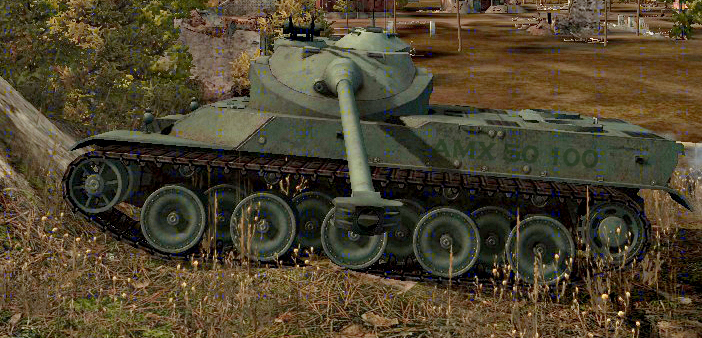
.png)
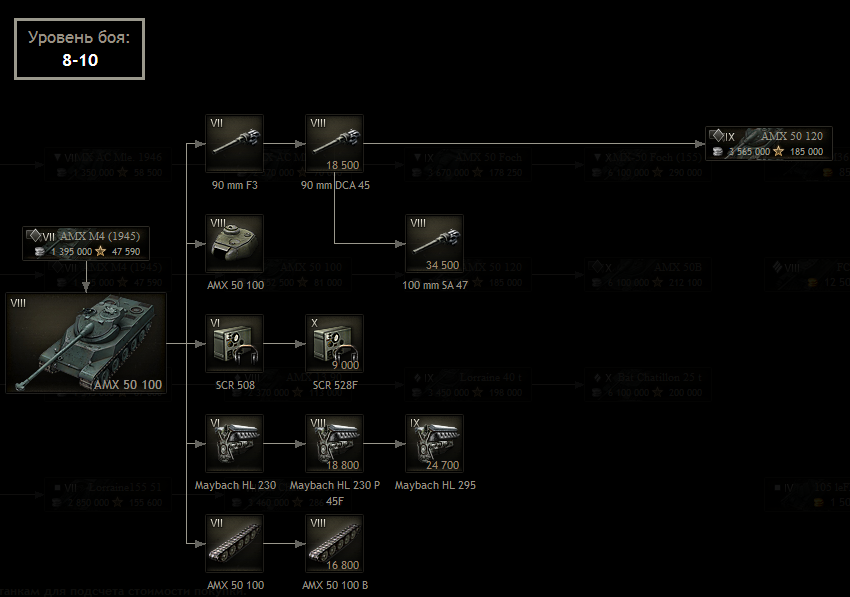
.png)
.png)


.png)






